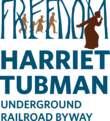41. Corbit-Sharp House
Jill Jasuta2023-07-28T14:12:44-04:0041. Corbit-Sharp House
A Place of Refuge
Slavery in Delaware was truly a “peculiar institution.” The population struggled between powerful slave interests and defiant anti-slavery groups. Despite lobbying attempts by religious leaders, abolitionists and ordinary citizens to end slavery in the state, Delaware remained firmly proslavery. The town of Odessa stood at a crossroads both culturally and geographically. Odessa’s Quaker, abolitionist, and free black communities offered secret help on a heavily traveled Underground Railroad route.
The Historic Odessa Foundation’s exhibit, “Freedom Seekers: The Odessa Story” highlights the role these groups played in helping slaves escape, including Sam, a fugitive slave who approached the Corbit-Sharp House for help in the 1840s. The Corbit-Sharp House, c. 1772, was the home of Quaker abolitionists, Daniel and Mary Corbit. He was hidden cleverly by Mary Corbit, and a sheriff’s posse failed to discover him. At dusk, Daniel Corbit provided food and money and sent him north.
Through the Historic Odessa Foundation, you can tour the Corbit-Sharp House c. 1772, Wilson-Warner House c. 1769 and Collins-Sharp House c. 1770. Special interactive programs explore 18th- and 19th century domestic life, economics, crafts and politics. Changing exhibits, lectures, and holiday programs create a vibrant atmosphere.
Information
Address
Historic Odessa Foundation
201 Main Street Odessa, DE 19730
302-378-4119
www.historicodessa.org
GPS Coordinates: 39.454821, -75.656596
Practical info
- Museum
- Programs & Tours
- Interior Exhibits







